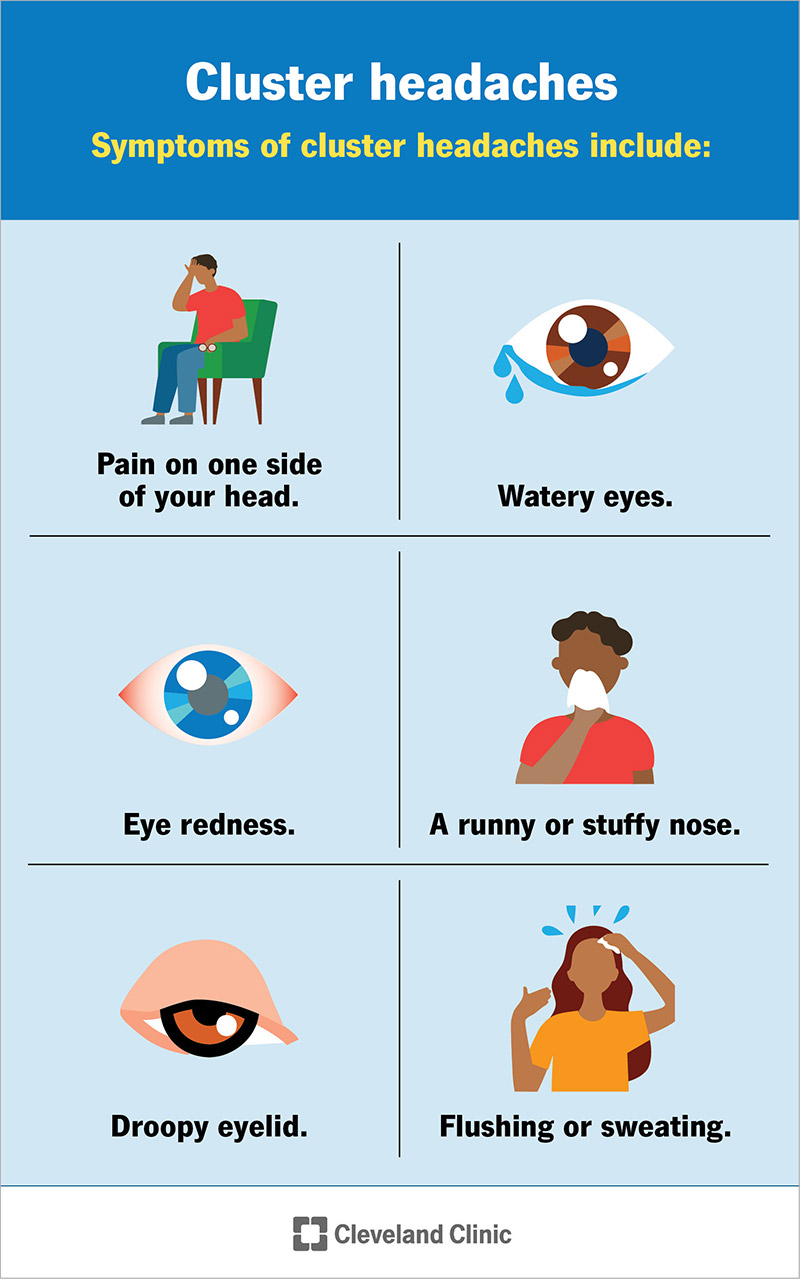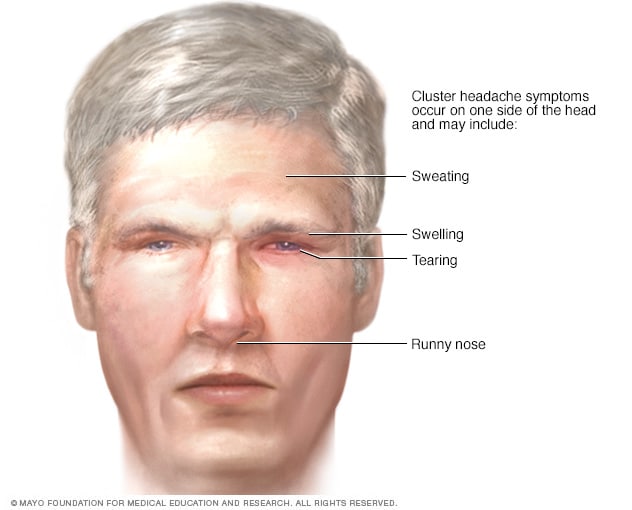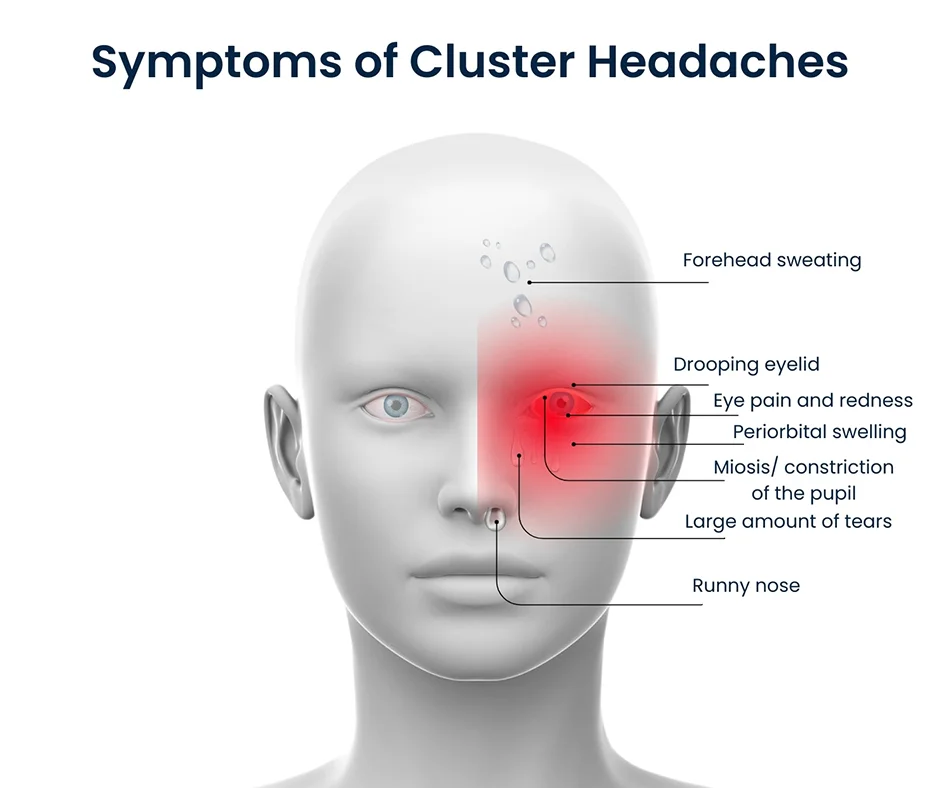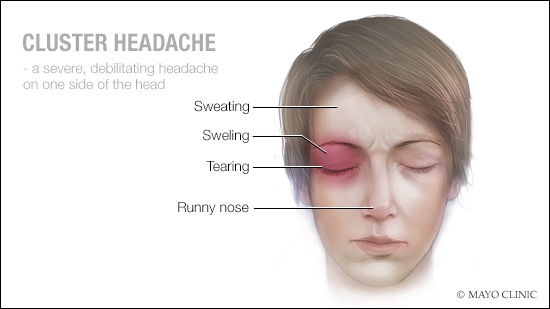Topic cluster headache: Explore the world of cluster headaches, a condition marked by intense pain but manageable with the right knowledge and strategies for relief and prevention.
Table of Content
- What are the symptoms of cluster headaches?
- What Are Cluster Headaches?
- Signs and Symptoms of Cluster Headaches
- Causes and Triggers of Cluster Headaches
- Diagnosing Cluster Headaches
- Treatment Options for Cluster Headaches
- Home Remedies and Lifestyle Changes
- YOUTUBE: Cluster Headaches: \"Like Someone Is Grabbing Your Face\" - BBC News
- When to See a Doctor
- Prevention Strategies for Cluster Headaches
- The Impact of Cluster Headaches on Daily Life
- Support and Resources for People with Cluster Headaches
What are the symptoms of cluster headaches?
Cluster headaches are characterized by intense, debilitating pain that tends to occur in cycles or clusters. The symptoms of cluster headaches include:
- Severe pain: The pain of a cluster headache is usually on one side of the head, often around or behind the eye. It is described as a burning or piercing sensation and is often described as one of the most severe types of pain.
- Duration: The pain typically lasts between 15 minutes and 3 hours.
- Frequency: Cluster headaches occur in cycles or clusters, with episodes of frequent attacks followed by periods of remission. These cycles can last for weeks or even months.
- Tearing and redness of the eye on the affected side
- Swelling and drooping of the eyelid on the affected side
- Stuffy or runny nose on the affected side
- Restlessness and agitation
- Sensitivity to light and sound
It is important to note that cluster headaches can vary in severity and frequency from person to person. If you suspect you may be experiencing cluster headaches, it is important to consult with a healthcare professional for an accurate diagnosis and appropriate treatment.
What Are Cluster Headaches?
Cluster headaches are a form of headache known for their extreme pain and occur in cyclical patterns or clusters. These headaches are one-sided, typically affecting the area around one eye or the temple, and are often accompanied by symptoms such as eye redness, tear production, and nasal congestion on the affected side. Unlike migraines, cluster headaches occur quickly and without warning. The exact cause is unknown, but they are believed to be related to the body"s biological clock, housed in the hypothalamus. Cluster headache periods can last for weeks or months, followed by remission periods where the headaches stop.
- Intensity: The pain from cluster headaches is often described as piercing, burning, or throbbing.
- Duration: Each headache can last between 15 minutes to 3 hours and may occur several times a day.
- Time of Occurrence: They are more common at night, often waking sufferers from sleep.
- Risk Factors: Smoking, alcohol consumption, and a family history of cluster headaches may increase the risk.
Understanding the nature of cluster headaches is crucial for seeking appropriate treatment and managing the condition effectively.
:max_bytes(150000):strip_icc()/VWH-PaigeMcLaughlin-WhatisaClusterHeadache-Standard-87c962b6a28d4b1ab0359ed3ae5b696f.jpg)
Signs and Symptoms of Cluster Headaches
Cluster headaches are known for their distinctive symptoms, which can significantly impact those affected. Understanding these signs is crucial for early detection and management.
- Intense Pain on One Side of the Head: Typically occurring around the eye or temple, the pain is sharp, penetrating, and often described as burning or piercing.
- Restlessness: Unlike migraines, individuals with cluster headaches may feel restless and unable to stay still during an attack.
- Eye Symptoms: The eye on the affected side may become red, swollen, and exhibit droopiness of the eyelid, along with tearing.
- Nasal Congestion: The nostril on the affected side may run or become congested.
- Sensitivity to Light and Sound: Although more common in migraines, some individuals may experience this with cluster headaches.
- Frequency of Attacks: Attacks can occur several times a day, lasting between 15 minutes and 3 hours, and often happen at the same time of day.
- Series of Headaches: These headaches can come in clusters, occurring for weeks or months at a time, followed by periods of remission.
Recognizing these symptoms is a step forward in managing cluster headaches effectively and seeking appropriate treatment.
Causes and Triggers of Cluster Headaches
Cluster headaches, while their exact cause is unknown, are believed to be related to the body"s sudden release of histamine or serotonin. This release affects the body"s autonomic nervous system, leading to pain and other symptoms. Factors that may trigger cluster headache episodes include:
- Alcohol consumption, especially during cluster periods.
- Certain foods high in nitrates, like processed meats.
- Strong smells, such as perfume, paint, or gasoline.
- Bright or flashing lights.
- Changes in altitude or air pressure.
- Exertion or physical activity.
- Hot weather or overheated environments.
- Certain medications, or skipping doses of headache preventive medication.
- Stress or emotional distress.
Identifying and avoiding these triggers can help manage and reduce the frequency of cluster headache attacks for many sufferers.

Diagnosing Cluster Headaches
Diagnosing cluster headaches involves a thorough understanding of the symptoms and distinguishing them from other types of headaches. Medical professionals typically follow a step-by-step approach to ensure an accurate diagnosis.
- Patient History: A detailed account of the headache patterns, pain characteristics, and any associated symptoms.
- Physical and Neurological Examination: Assessing for physical signs and neurological function to rule out other causes.
- Diagnostic Criteria: Meeting specific criteria defined by the International Headache Society, including the frequency and duration of attacks.
- Imaging Tests: While not typically necessary for diagnosis, imaging tests like MRI or CT scans may be used to exclude other conditions.
- Referral to a Specialist: Consulting with a neurologist or headache specialist for complex cases or confirmation of the diagnosis.
Early diagnosis and treatment are crucial for managing cluster headaches effectively and improving the quality of life for those affected.
Treatment Options for Cluster Headaches
Treating cluster headaches focuses on reducing severity and frequency of attacks. No single treatment works for everyone, but options include:
- Oxygen Therapy: Breathing pure oxygen through a mask can often stop or reduce the pain within a short time.
- Medications: The use of specific prescription medications, such as triptans and ergotamines, can be effective when taken at the onset of headache symptoms.
- Preventive Treatments: Medications like verapamil, a calcium channel blocker, are used to decrease the frequency of cluster headaches.
- Corticosteroids: A short course may be effective in breaking a cycle of cluster headaches.
- Neuromodulation Techniques: Procedures like occipital nerve stimulation or deep brain stimulation have shown promise for treatment-resistant cases.
- Lifestyle Adjustments: Avoiding alcohol and smoking, maintaining a regular sleep schedule, and managing stress can help reduce the frequency of headaches.
Consultation with a healthcare provider is crucial for developing an effective treatment plan tailored to individual needs and circumstances.

Home Remedies and Lifestyle Changes
Managing cluster headaches includes not only medical treatments but also home remedies and lifestyle adjustments that can help reduce the frequency and severity of attacks. Here are some strategies that individuals have found beneficial:
- Maintain a Regular Sleep Schedule: A consistent sleep pattern can help prevent cluster headache episodes.
- Avoid Alcohol and Smoking: Both alcohol and smoking can trigger cluster headaches in susceptible individuals.
- Stress Management: Techniques such as meditation, yoga, and deep-breathing exercises can reduce stress, which may in turn lessen the frequency of headaches.
- Exercise Regularly: Regular, moderate exercise may help by improving overall health and stress management.
- Cool Compresses: Applying a cool cloth or ice pack to the area of pain during an attack may offer temporary relief.
- Avoid High Altitudes: Rapid changes in altitude can trigger headache episodes, so it may be beneficial to avoid high altitudes if possible.
- Healthy Diet: A balanced diet rich in fruits, vegetables, and whole grains can support overall health and potentially reduce headache triggers.
It"s important to consult with a healthcare provider before making significant lifestyle changes or starting any new remedy, especially if you"re already under treatment for cluster headaches. These home strategies should complement, not replace, professional medical advice and treatments.
Cluster Headaches: \"Like Someone Is Grabbing Your Face\" - BBC News
Experience the gripping intensity of cluster headaches in this eye-opening BBC News video. Get a real understanding of what it feels like when it seems like someone is grabbing your face and learn how to empathize with those who suffer from this excruciating pain.
New Device Offers Relief for Cluster Headaches
Dealing with the unbearable pain of cluster headaches? Discover a groundbreaking new device that offers relief in this informative and hope-filled video. Learn how this innovative technology is revolutionizing the way cluster headache sufferers manage and alleviate their symptoms, bringing them newfound comfort and quality of life.
When to See a Doctor
Knowing when to consult a healthcare provider is crucial in managing cluster headaches effectively. Seek medical advice if you experience:
- Unusually severe headache or a pattern change in headaches.
- Headaches that are not relieved by over-the-counter pain medication.
- Symptoms that disrupt your daily life or sleep patterns.
- Headaches accompanied by other symptoms such as fever, stiff neck, confusion, seizures, double vision, weakness, numbness, or speaking difficulties.
Early diagnosis and treatment can help manage the symptoms of cluster headaches and improve your quality of life. A healthcare provider can offer tailored advice and treatment plans, including possible referrals to specialists such as neurologists.

Prevention Strategies for Cluster Headaches
Preventing cluster headaches focuses on identifying and avoiding triggers, maintaining a regular sleep schedule, and possibly using preventive medication. Lifestyle adjustments and understanding your headache patterns play crucial roles in reducing the frequency and severity of attacks. Here are key strategies:
- Avoid alcohol and smoking, as these are known triggers.
- Maintain a consistent sleep schedule, even on weekends.
- Manage stress through relaxation techniques such as meditation, yoga, or deep-breathing exercises.
- Regular physical activity can also help manage cluster headache patterns.
- Work with your doctor to identify any additional personal triggers to avoid.
- Consider preventive medications or treatments, such as verapamil, lithium, or corticosteroids, under the guidance of a healthcare professional.
- Oxygen therapy and nerve blocks are other preventive measures that some patients find effective.
It"s important to consult with a healthcare provider to develop a personalized prevention plan that considers your specific situation, triggers, and overall health.
The Impact of Cluster Headaches on Daily Life
Cluster headaches, known for their intense pain, can significantly affect daily activities, work, and personal relationships. However, understanding and managing their impact can lead to a more balanced life. Here"s how they can affect daily living:
- Work and Productivity: The sudden onset of pain can disrupt work, leading to difficulties in maintaining concentration and completing tasks efficiently.
- Social Interactions: The unpredictability of attacks may affect social plans, causing individuals to withdraw from social activities or experience anxiety in social settings.
- Mental Health: The chronic nature of cluster headaches can lead to stress, anxiety, and depression, impacting overall well-being.
- Sleep Patterns: Attacks often occur at night, disrupting sleep and leading to fatigue and decreased energy levels during the day.
- Lifestyle Limitations: To avoid triggering attacks, individuals may need to make significant lifestyle changes, such as avoiding alcohol, maintaining strict sleep schedules, and managing stress.
Despite these challenges, many find effective ways to manage their condition through medical treatments, lifestyle adjustments, and support from healthcare providers and support groups. By taking proactive steps, individuals can minimize the impact of cluster headaches on their daily lives and improve their quality of life.

Support and Resources for People with Cluster Headaches
Finding support and reliable resources is crucial for those living with cluster headaches. A range of options is available to help manage the condition, connect with others facing similar challenges, and improve quality of life. Here are key resources:
- Healthcare Providers: Neurologists and headache specialists who have experience with cluster headaches can offer personalized treatment plans and advice.
- Support Groups: Both online and in-person support groups provide a platform to share experiences, advice, and encouragement with others who understand the unique challenges of living with cluster headaches.
- Online Forums and Social Media: Websites and social media platforms dedicated to cluster headaches are valuable resources for information sharing, support, and advocacy.
- Educational Resources: Trusted medical websites and organizations offer articles, research updates, and detailed guides on managing cluster headaches.
- Advocacy Groups: Organizations focused on headache disorders advocate for research, improved treatments, and awareness, providing a voice for those affected.
- Therapy and Counseling: Professional counseling can help manage the emotional and psychological impact of living with a chronic condition like cluster headaches.
Engaging with these resources can empower individuals with cluster headaches to lead fuller lives, despite the challenges posed by the condition. Encouragement, education, and community support play vital roles in navigating the journey with cluster headaches.
Embracing the journey with cluster headaches is challenging, yet with the right support and resources, managing this condition becomes achievable, opening doors to a life of wellness and empowerment.